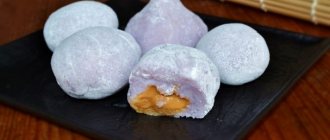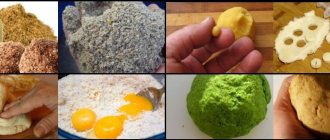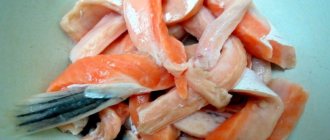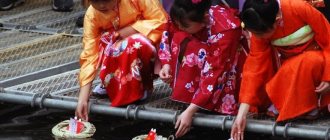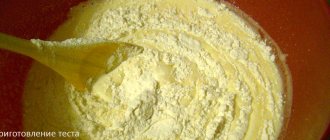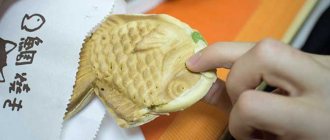The Art of Wagashi
In Japan they say that wagashi is the most attractive part of the art of Japanese cooking. And this is, first of all, because each cake is made by hand using the fingertips of the skilled hands of the master and a piece of the soul that he puts into his creation.
Color, shape, size? The Wagashi will tell us everything the artist wanted to tell us. Just as a piece of music cannot be played the same way several times, it is impossible to create identical wagashi. The smell of wagashi is the smell of nature. All plants smell differently - rice, beans, mint and ginger, and the incomparable smell of green tea, familiar to every Japanese since childhood. It is the aroma of nature that we inhale when we bring wagashi to our lips.
For those who have a desire to express themselves in the culinary arts, it will not be difficult to prepare some varieties of wagassi
Motti recipe (base)
Many wagashi sweets are prepared
on the basis of motchi. These are koloboks or cakes made from steamed and crushed white rice. They are even given as souvenirs and used to decorate the house. In Japan, mochi is a must for the New Year. Mochi comes with or without a variety of fillings , toasted or not.
For mochi, special varieties of rice with increased stickiness are chosen. It is washed, boiled, and then transferred to a tall wooden mortar and beaten forcefully with mallets, which are a cylindrical roller with a long handle.
During the “beating” process, the resulting mass is constantly flavored with a small amount of water and turned over to the other side with wet hands. The main thing here is not to overfill the water, otherwise the mass will turn out too liquid. Gradually, under the blows of the beater, the rice turns into a dense, soft lump of snow-white dough. It is taken out and divided into small balls, which are rolled in a variety of powders - from sweet powdered sugar, sesame seeds, to all kinds of seasonings and spices.
That's all, the mochi can be considered ready. Thanks to the elasticity of the dough, mochi can be given different shapes to suit the season and event: fluffy snow balls, multi-colored chrysanthemums, exquisite fruits - whatever your imagination allows.
Traditional Mochi flatbreads: recipe
Ingredients: Mochi-gome rice (you can also use regular rice) - 1000 g, soybeans (adzuki) or small red beans - 500 g, sugar - 500 g, blueberry syrup - to taste, green tea powder (matcha) - to taste (it can be found in specialized tea stores), rice or wheat flour - to taste.
Preparation: First you need to prepare the rice and beans. To do this, soak the beans in warm water for a day, and wash the rice thoroughly and soak in cold water overnight. The next day, boil the beans with sugar until a homogeneous mass is obtained, and drain the water from the rice and cook for 30-40 minutes. After this, transfer the rice into a wooden bowl and grind until it becomes a homogeneous sticky mass. Add a little ink syrup and green tea powder to it for color. Our dough is ready. It's time to make cakes. For this we prepare a surface sprinkled with flour, on which we form small thick cakes from the resulting dough. Place a teaspoon of adzuki paste inside and serve immediately.
Cooking method
Step 1
Adzuki beans must be boiled with 100 g of sugar for 45 minutes. This will take 2 cups of water. Afterwards, cool the beans and beat them to a paste using a blender.
Step 2
In a ceramic saucepan, separately mix the remaining sugar with salt, tea and glutinous rice flour with 1 cup of water. Mix thoroughly until a homogeneous mass is obtained. Afterwards, the saucepan is tightly packed with cling film and placed in the microwave for 3 minutes at maximum heat. The Japanese recipe calls for a homogeneous and viscous mochi dough. If you get this consistency, leave it aside to cool. If not, microwave for another minute.
Step 3
While the glutinous rice flour dough is cooling, form the bean paste into balls.
Step 4
Knead the cooled dough thoroughly. After all, thoroughly kneaded dough is the main secret of delicious mochi. Moreover, the Japanese even hit it with a rolling pin for 4 minutes to get the required consistency.
Step 5
The dough is ready, which means it's time to prepare the place for modeling. I sprinkle the table with starch. You shouldn’t forget about your hands either, this way the dough won’t stick. Then roll out the sausage and cut it into 8 equal pieces.
Step 6
Since glutinous rice flour dough dries quickly, wrap all parts in cling film.
Step 7
Take one of the pieces of dough and knead it into a thin round cake. Place the bean paste filling inside and wrap it up.
Step 8
We repeat this procedure with the remaining pieces. If you do not add powdered tea, then the Japanese dessert mochi will look like this:
Step 9
This sweet is usually served with green tea. Although I have tried them with coffee too. And I can say that it is very tasty!
Dango recipe
- pieces of mochi, strung on wooden skewers and drizzled with syrup
Ingredients: rice flour 100 g sugar 20 g warm boiled water 50 g salt to taste
For decoration: sugar 10 g cinnamon powder 3 g sesame seeds 5 g
Preparation: In a clean bowl, mix rice flour with sugar and salt, add warm boiled water and mix everything. Knead the dough and form several small balls from it. Place the buns in a bowl and steam for 20-30 minutes. Place the finished balls on the table or cutting board, combine and knead well, then form the balls again. Pour sugar into a clean saucepan, add ground cinnamon and mix everything. Lightly fry the sesame seeds in a dry frying pan and then mix with sugar. Roll half of the cooked buns in the cinnamon mixture, and the other half in the sesame mixture.
After that, alternately string white and dark balls onto small skewers and serve the dish.
How to make Wagashi mochi cakes at home
Ingredients for the dough:
- Rice flour – 150 gr.
- Powdered sugar – 50 gr.
- Water – 300 ml.
- Starch for sprinkling (corn is best) – 50 g.
- Food coloring if you want to color the brownies.
For the filling, you can take chocolate, peanut or sesame paste, jam (do not confuse it with jam, jam holds its shape better and your cake will not “flow” with it) or boiled condensed milk. The main thing to remember is that the filling should not be liquid, but it should be soft enough to harmonize with the delicate rice dough.
Dessert recipe
- First of all, mix the rice flour and powdered sugar in a small saucepan, iron bowl or double boiler.
- After this, carefully add water to the mixture and mix.
- Then put it in a water bath, stirring from time to time, or turn on the double boiler. The preparation time for our dough will be about 20 minutes. The finished mass should be elastic and a little “rubbery”.
- After the mass “reaches”, carefully pull it out onto a table surface sprinkled with starch. The mixture should be thick enough to form into a ball.
- Using your hands, form a sausage from a ball about 5-6 cm in diameter.
- We cut the “sausage” into circles by analogy with dumplings. Flatten each circle with your hands and immediately put about a teaspoon of filling in the middle, then cover the filling with dough so that you end up with a ball.
- Lightly roll each ball in starch and place on a plate.
So, the cakes are ready! However, such a dessert must be eaten within a few hours after preparation, otherwise it will dry out, crack and lose all its unique taste.
Classic mochi without filling is made in almost the same way.
Classic mochi
Recipe
- The mixture needs to be kept in a water bath a little longer.
- Place it on the surface to form not a ball, but a rectangle.
- Then simply cut the rectangle into small squares, roll in starch (for sweetness, you can add a little powdered sugar to the starch) and place on a dish.
You also need to eat them as quickly as possible. If there is still some mochi left, you can freeze them, but you need to defrost them in a bag or under film so that during the defrosting process the cakes do not dry out and become airy. As you can see, the process of making these cakes will only take half an hour, but the resulting dessert will undoubtedly surprise you with its unusual taste!
Try it, bon appetit!
Video recipe for making Mochi cakes
Manju
- a dessert made from wheat flour filled with sweet bean paste. Sweet Potato, Apple and Bean Paste Pie Recipe.
Ingredients: 250g canned neri-an (Japanese soft adzuki bean paste). For liquid dough: 6 tbsp. spoons of plain flour, a pinch of sugar, 5 tbsp. spoons of water.
For the sweet potato and apple filling: 150g sweet potato (yam), 1/4 apple, 200ml water, 50g sugar, 1/4 lemon.
Preparation: Place all the ingredients for the batter in a bowl and mix until smooth. Sweet potatoes need to be cut into cubes and left in cold water for 5 minutes (to get rid of bitterness). Then drain the water. Apples need to be coarsely chopped, put in a saucepan, add water, add sweet potatoes and sprinkle with a little sugar. Cook the resulting mixture over medium heat until the apple and potatoes are soft. Then add lemon juice and remove the pan from the heat. Drain the water, and mash the mixture of potatoes and apples in a bowl with the remaining sugar until uneven.
Form small cubes from this mass, roll them in batter and place in a frying pan. You need to fry each side of the cube so that the dough is baked. The pies are ready!
Wagashi recipes: continued>>
Main varieties of wagashi
* Mochi - balls or flatbreads made from steamed and crushed white rice. They come with and without various fillings, fried or not. * Yokan - sweetish bean paste and agar-agar. * azuki paste - used as a filling for various types of wagashi * Amanatto - dried beans coated in sugar (see Natto) * Ame - a type of caramel made from starch and sugar * Ammitsu - pieces of chilled agar-agar jelly with fruit and sweet gravy * Botamochi - mochi coated on the outside with adzuki bean paste * Warabimochi - pieces of clear dough made from warabi (young fern shoots). Served with sweet kinako soy flour and kuromitsu burnt sugar syrup * Gyuhi is a softer version of mochi. Typically made from a mixture of rice and rice flour. * Daifuku - a basic type of mochi filled with adzuki paste * Dango - pieces of mochi skewered on wooden skewers and topped with syrup * Dorayaki - two round sponge cakes filled with adzuki paste * Imagawayaki - fried pie filled with azuki paste * Kashiwamochi - mochi filled with azuki paste wrapped in a salted oak leaf * Kinkato - sugar caramel * Kintsuba - fried unleavened dough patty filled with azuki paste * Kusamoti - greenish-colored mochi made with Japanese mugwort yomogi * Manju - steamed patties filled with azuki paste * Monaka - two thin crispy waffles filled with adzuki paste * Nerikiri - cakes made from white bean paste, sugar and gyuha (see above) or grated nagaimo (a type of mountain yam) * Rakugan - hard candy with a high sugar content, used during tea ceremony - see Tea Ceremony * Sakuramochi - mochi wrapped in a salted cherry leaf * Shogato - candied ginger * Shiruko (also zenzai) - a traditional New Year's sweet, sweet bean soup with pieces of mochi * Tayaki - a type of imagawayaki, made in the shape of a fish * Uiro - steamed cakes made from rice flour and sugar, similar to mochi
Wagashi Recipes 2
Origin story
It is believed that the first sweets in traditional Japanese food appeared more than a thousand years ago. In the 8th–9th centuries, the inhabitants of the islands began to interact with their Chinese neighbors. Along with Buddhism and some cultural features, rice cooking technologies began to penetrate their lives. The nascent art of confectionery was the privilege of only a handful of craftsmen who created very expensive and rare sweets. Nevertheless, by the beginning of the 9th century, the main canons of classical Wagashi had developed, some of which are revered to this day.
Traditional Japanese desserts underwent major changes in the 14th–16th centuries, when the Land of the Rising Sun established trade relations with European countries. From Spain, considered at that time the mistress of the seas, new recipes and ingredients arrived, thanks to which the delicacies became much more diverse. It was during this period that red adzuki beans, legumes, flour, dried fruits and sugar began to be added to traditional desserts.
By the 18th–19th centuries, desserts of Japanese cuisine began to resemble modern ones, and their widespread distribution in big cities led to the fact that almost all classes began to feast on the products of local confectioners. And also at this time, the tradition of serving sweets with green tea arose.
The name Wagashi itself appeared only at the beginning of the 20th century. It comes from the word "Wa", which means "Japan". Some historians believe that in this way the islanders wanted to emphasize the national identity of the desserts, hiding the fact that ideas from Western sweets were often used to prepare them.
